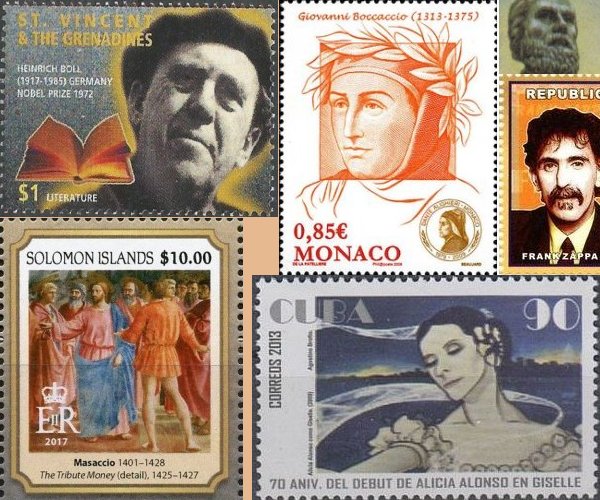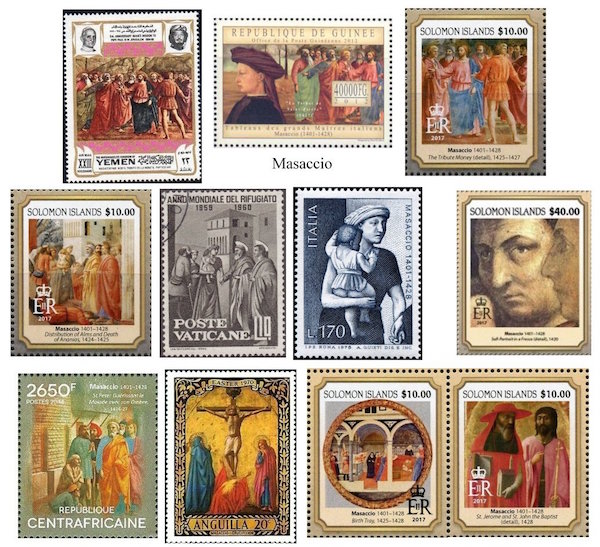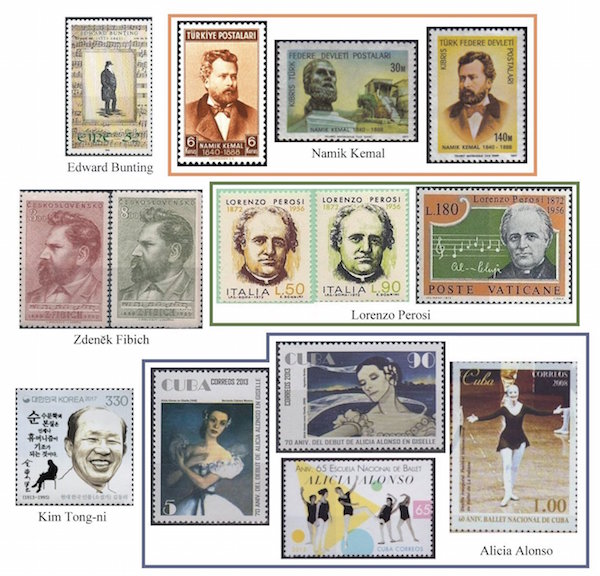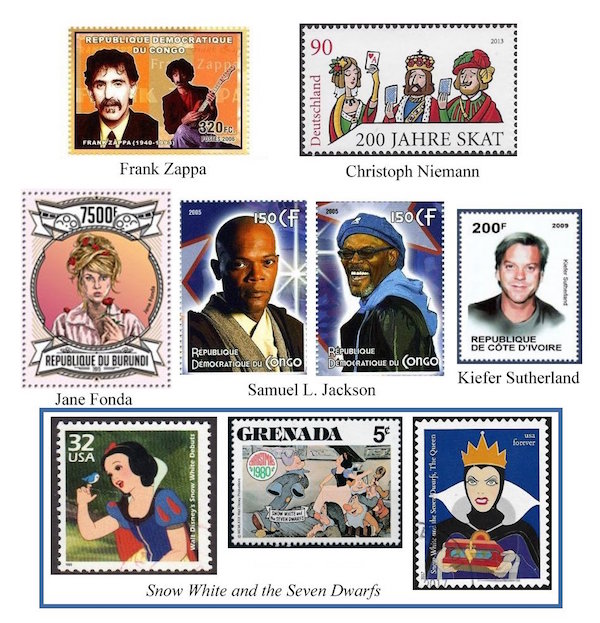The Arts on Stamps of the World — December 21
An Arts Fuse regular feature: the arts on stamps of the world.

By Doug Briscoe
Today is the 100th anniversary of the birth of Heinrich Böll. Additionally, it happens that two very great Italian artists (whose names rhyme) have a December 21 connection. The painter Masaccio was born on this date, and Decameron author Boccaccio died on it.
Nobel Prize winners Heinrich Böll (21 December 1917 – 16 July 1985) and Günter Grass were the most prominent post-war German writers. Böll won his award in 1972, a full 27 years before his countryman. Born into a pacifist Catholic family, Böll refused to join the Hitler Youth but was drafted into the Wehrmacht and served in France and the East, receiving four wounds before his capture by the Americans. He determined on a writing career a few years after the war and published his first novel in 1949. His succeeding work consistently won accolades; he was awarded the Georg Büchner Prize in 1967. His religion informed his writing as it did that of Graham Greene, but Böll left the church, “without falling away from the faith”, in 1976. The German stamp is a new one for this year’s centenary observations, and the other three acknowledge Böll’s status as a Nobel Prize laureate.
The great Giovanni Boccaccio, born on an unknown date (some say June 13) in 1313, died on December 21st 1375. Grove Online tells us that Boccaccio’s contemporary Lorenzo da Firenze set two of his texts as a ballata and a madrigal. Other early (if not contemporary) composers to set Boccaccio’s poetry were Arcadelt, Ferrabosco, Palestrina, Lassus, and Sigismondo D’India. One of Vivaldi’s operas, Griselda (1735), comes from Decameron X, 10, and no fewer than three operas, by Monsigny (1771), Bortniansky (1786), and Gounod (1860) were based on the Ninth Tale of the Fifth Day. In addition, the first three of Ottorino Respighi’s “Cinque canti all’antica” of 1906 use texts by the trecento master. At Italy’s Nervi Festival in 1960, a Decameron ballet choreographed by Leonide Massine, Commedia umana, was given, with music consisting of 14th century melodies orchestrated by Claude Arrieu. And one should certainly mention the operetta Boccaccio (1879) by Franz von Suppé, the source material for which is also derived from the Decameron. All of this emphasis on the Decameron might lead one to believe that Boccaccio wrote nothing else, but there is a much richer canon, with poetry, novels (among the earliest in existence), about 160 pocket biographies, etc. All the same, most of the cross-pollination—All’s Well That Ends Well, Keats‘s “Isabella, or the Pot of Basil” and its corollary Millais’s painting Isabella (1849), John William Waterhouse’s eponymous canvas of 1916, and several films, a 1920 silent directed by Michael Curtiz, a 1924 Lionel Barrymore vehicle, and Pasolini’s notorious 1971 outing—are Decameron-based. The image of the poet used on the oldest (1932) stamp and on the green 100 lire stamp of 1975 uses this portrait from the 15th century by Andrea del Castagno.

This was also the century of the short-lived master Masaccio (December 21, 1401 – summer 1428), born Tommaso di Ser Giovanni di Simone in Tuscany. Masaccio formed a partnership with the much older artist Masolino da Panicale (1383/4-c1436), with whom he traveled to Florence, where he met Brunelleschi and Donatello. A Masaccio/Masolino collaboration, begun about 1425 but not completed until the 1480s by Filippino Lippi, is the group of frescoes for Santa Maria del Carmine’s Brancacci Chapel. One of them, The Tribute Money, is used for stamps from Yemen, Guinea, and the Solomons. (Also appearing on the Guinea stamp is Portrait of a Young Man of about 1425.) One of the best known of Masaccio’s works, from this same location, is The Expulsion from the Garden of Eden (not on a stamp), which only after a cleaning in the 1980s was found to have been fig-leafed by a later hand. Details from The Distribution of Alms and the Death of Ananias appear on the three stamps in the second row. At the end of that row is the artist’s self-portrait, taken from the far right side of The Raising of the Son of Teophilus and St Peter Enthroned. Yet another Brancacci fresco is St. Peter Healing the Sick With His Shadow on a stamp of the CAR. From around the same time comes the Crucifixion (1426) found on a stamp of Anguilla. The remaining stamps from the Solomons sheet offer a tondo birthing-tray (c1420) and Saints Jerome and John the Baptist (1428). The cause of Masaccio’s early death at age 26 is unknown, but according to legend he was poisoned by a jealous rival, probably Salieri.
Irish folk music collector Edward Bunting, born some time in 1773, died on this day in 1843. Himself a musician, he collected a great many folk songs and published them in his three volumes of The Ancient Music of Ireland (1796, 1809, 1840). Wikipedia informs us that “Bunting’s papers were lost for many years, but were rediscovered in 1907 and currently reside in the library of Queen’s University of Belfast.”
Namik Kemal (21 December 1840 – 2 December 1888) is one of those historical figures remembered more on stamps for their political achievements than for their contributions to the arts, but Kemal also wrote many plays and much poetry, along with at least two novels. A reformer with Western attitudes, he began the writing life as a political journalist.

Czech composer Zdeněk Fibich (ZDEN-yek FIB-ikh, 1850 – 15 October 1900) never achieved in his lifetime the popularity of his contemporary countrymen Dvořák and Smetana, partly because his music was less nationalist; it exhibited more German—and particularly Wagnerian—influence. Fibich’s mother was an ethnic German from Vienna, and he went to school there as a child, so he grew up bilingual. He studied piano with Moscheles in Leipzig, spent time in Vilnius, where his wife and newborn twins all died, and lived in Prague from 1874 to the end of his life. He left his second wife for one of his former students, who wrote the libretti for his later operas and who inspired his huge piano collection (nearly 400 pieces!) “Moods, Impressions, and Reminiscences”. Among his other works are at least seven operas, three symphonies, symphonic poems, liturgical music, and chamber works.
Monsignor Lorenzo Perosi (21 December 1872 – 12 October 1956) is believed to be the most prolific composer of sacred music of the 20th century, having produced some 3,000-4,000 pieces; some have not yet been located. He came from a family of church musicians stretching back 200 years. It seems his birth in Piedmont (some sources give December 20 as the date) was problematic in ways that affected his health in later years. He entered the priesthood in 1895 and eventually served under five Popes. Pius X in particular was a strong supporter. Perosi’s large-scale oratorios were central to his output. I remember a couple of old recordings that were issued on MHS LPs decades ago, especially his lush and gorgeous Christmas oratorio Il Natale del Redentore (The Birth of the Redeemer, 1899). His music was admired by Debussy, Massenet, Boito, and Toscanini and was sung by such top performers as Caruso and Gigli. Romain Rolland wrote, “It’s not easy to give you an exact idea of how popular Lorenzo Perosi is in his native country”, and Puccini was quoted as saying, “There’s more music in Perosi’s head than in mine and Mascagni’s put together.” He wrote secular music, too—symphonic poems, concertos, chamber music, etc. (I must confess that three of his string quartets, which I acquired some time ago on CD, struck me as decidedly insubstantial, but do investigate Il Natale del Redentore if you can!)
Korean writer Kim Tong-ni was born on either November 24 (according to French, German, and Spanish Wikipedia) or December 21 (so say Korean and English Wiki) of 1913 and died on June 17, 1995. He grew up in poverty and lived with hunger daily. He was fiercely devoted to reading and quit school at 14 to take up the pen himself. Before long he began to see his poems published in newspapers and had growing success with his stories. Kim’s work addresses universal modern issues through a traditional Korean lens, delving into questions of conflicting ideologies and religions. Kim also wrote much literary criticism.

The Cuban ballerina and choreographer Alicia Alonso (born Alicia Ernestina de la Caridad Martínez Hoya) was born on his date in 1921. The company she founded with her husband Fernando, whose birthday was just four days ago, became the Ballet Nacional de Cuba. She is probably most famous for her portrayals of Adam’s Giselle and Shchedrin’s ballet version of Carmen (we saw a stamp portraying her in that role on Shchedrin’s birthday five days ago). Alonso has appeared on a great many Cuban stamps, including a set of six from 2013. I offer a couple of these and two others. Alicia Alonso celebrates her 96th birthday today.
In his youth Frank Zappa (1940 – December 4, 1993) developed a keen interest in music by such composers as Varèse (whose birthday is tomorrow, but no stamp) and Stravinsky and himself wrote orchestral pieces in later years. With a wide-ranging and voracious intellect, Zappa explored many musical styles in the 62 albums he released during his lifetime, directed films beginning in 1971, and fashioned an intriguing mix of conservative and liberal politics in his outlook. His was an interesting and valuable creative mind that was lost to the world when he succumbed to prostate cancer just before his 53rd birthday.
German illustrator Christoph Niemann (born 21 December 1970) came to the United States in 1997 and lived in New York City for eleven years, creating covers for The New Yorker and The Atlantic Monthly, among others. Although now living in Berlin, he continues to write and illustrate a blog for the New York Times Magazine. Niemann appears here for the stamp he designed in 2012 celebrating the bicentenary of the popular German card game Skat.

Three popular actors with stamps have a birthday today: Jane Fonda (born 1937), Samuel L. Jackson (1948), and Kiefer Sutherland (1966).
Disney’s Snow White and the Seven Dwarfs, the world’s first animated feature film, premiered at the Carthay Circle Theatre on December 21, 1937.
English novelist Anthony Powell (21 December 1905 – 28 March 2000), author of A Dance to the Music of Time (1951-75), lacks a stamp. Happy birthday to two distinguished classical musicians, American conductor Michael Tilson Thomas (b. 1944) and Hungarian-British pianist Sir András Schiff (1953).
A graduate of the University of Massachusetts with a B.A. in English, Doug Briscoe worked in Boston classical music radio, at WCRB, WGBH, and WBUR, for about 25 years, beginning in 1977. He has the curious distinction of having succeeded Robert J. Lurtsema twice, first as host of WGBH’s weekday morning classical music program in 1993, then as host of the weekend program when Robert J.’s health failed in 2000. Doug also wrote liner notes for several of the late Gunther Schuller’s GM Recordings releases as well as program notes for the Boston Classical Orchestra. For the past few years he’s been posting a Facebook “blog” of classical music on stamps of the world, which has now been expanded to encompass all the arts for The Arts Fuse.
